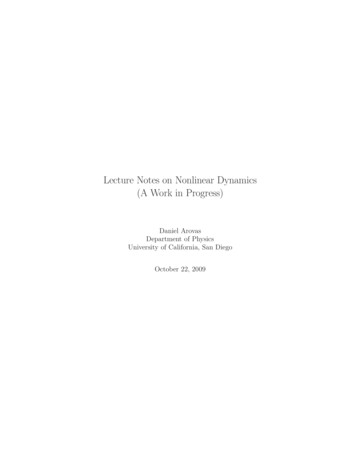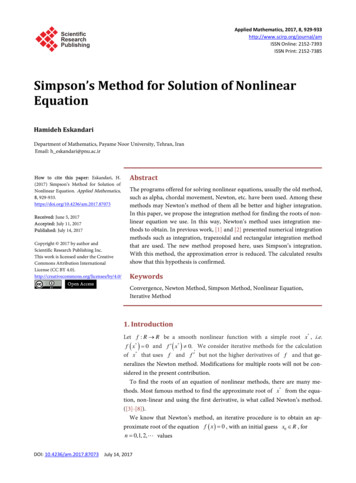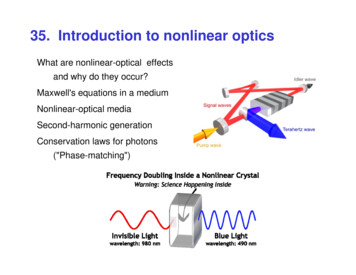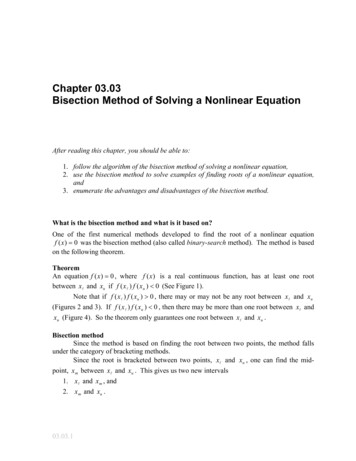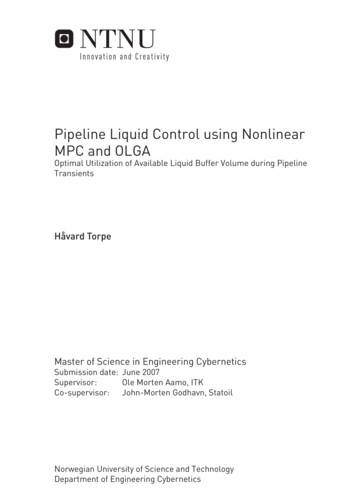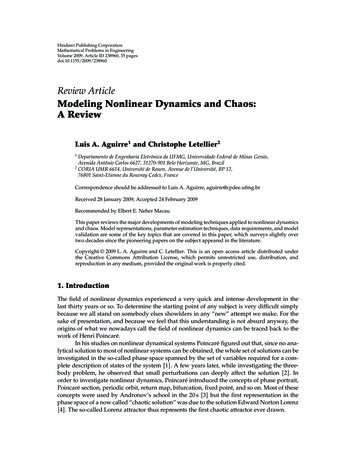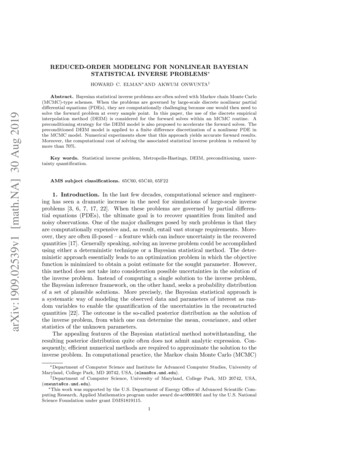
Transcription
REDUCED-ORDER MODELING FOR NONLINEAR BAYESIANSTATISTICAL INVERSE PROBLEMS arXiv:1909.02539v1 [math.NA] 30 Aug 2019HOWARD C. ELMAN AND AKWUM ONWUNTA†Abstract. Bayesian statistical inverse problems are often solved with Markov chain Monte Carlo(MCMC)-type schemes. When the problems are governed by large-scale discrete nonlinear partialdifferential equations (PDEs), they are computationally challenging because one would then need tosolve the forward problem at every sample point. In this paper, the use of the discrete empiricalinterpolation method (DEIM) is considered for the forward solves within an MCMC routine. Apreconditioning strategy for the DEIM model is also proposed to accelerate the forward solves. Thepreconditioned DEIM model is applied to a finite difference discretization of a nonlinear PDE inthe MCMC model. Numerical experiments show that this approach yields accurate forward results.Moreover, the computational cost of solving the associated statistical inverse problem is reduced bymore than 70%.Key words. Statistical inverse problem, Metropolis-Hastings, DEIM, preconditioning, uncertainty quantification.AMS subject classifications. 65C60, 65C40, 65F221. Introduction. In the last few decades, computational science and engineering has seen a dramatic increase in the need for simulations of large-scale inverseproblems [3, 6, 7, 17, 22]. When these problems are governed by partial differential equations (PDEs), the ultimate goal is to recover quantities from limited andnoisy observations. One of the major challenges posed by such problems is that theyare computationally expensive and, as result, entail vast storage requirements. Moreover, they are often ill-posed – a feature which can induce uncertainty in the recoveredquantities [17]. Generally speaking, solving an inverse problem could be accomplishedusing either a deterministic technique or a Bayesian statistical method. The deterministic approach essentially leads to an optimization problem in which the objectivefunction is minimized to obtain a point estimate for the sought parameter. However,this method does not take into consideration possible uncertainties in the solution ofthe inverse problem. Instead of computing a single solution to the inverse problem,the Bayesian inference framework, on the other hand, seeks a probability distributionof a set of plausible solutions. More precisely, the Bayesian statistical approach isa systematic way of modeling the observed data and parameters of interest as random variables to enable the quantification of the uncertainties in the reconstructedquantities [22]. The outcome is the so-called posterior distribution as the solution ofthe inverse problem, from which one can determine the mean, covariance, and otherstatistics of the unknown parameters.The appealing features of the Bayesian statistical method notwithstanding, theresulting posterior distribution quite often does not admit analytic expression. Consequently, efficient numerical methods are required to approximate the solution to theinverse problem. In computational practice, the Markov chain Monte Carlo (MCMC) Department of Computer Science and Institute for Advanced Computer Studies, University ofMaryland, College Park, MD 20742, USA, (elman@cs.umd.edu).† Department of Computer Science, University of Maryland, College Park, MD 20742, USA,(onwunta@cs.umd.edu). This work was supported by the U.S. Department of Energy Office of Advanced Scientific Computing Research, Applied Mathematics program under award de-sc0009301 and by the U.S. NationalScience Foundation under grant DMS1819115.1
2Efficient solver for nonlinear statistical inverse problemssampling techniques are probably the commonest methods used to explore the posterior distribution [3, 6, 7, 22, 25, 37]. For large-scale inverse problems involvingdiscretizations of nonlinear PDEs, however, the MCMC schemes can be computationally intractable because they require the solution of high-dimensional discretenonlinear PDEs at every sample point. This is the main focus of this work; here, weemploy state-of-the-art nonlinear model order reduction techniques within MCMCalgorithms to reduce the computational complexity of the statistical inverse problem.More specifically, following [4, 9, 15, 18] and the references therein, we apply thePOD-Galerkin method and a preconditioned discrete empirical interpolation method(DEIM) to accelerate the forward solves in our MCMC routine.The outline of the paper is as follows. A general formulation of the discrete nonlinear PDE model, as well as the associated statistical inverse problem we would liketo solve, is presented in Section 2. The MCMC scheme for sampling the posteriordensity of the unknown parameters in the inverse problem is presented in Section3. Section 4 discusses the reduced-order models which will be employed to facilitate the forward solves within the MCMC algorithm. Finally, Section 5 reports ourpreconditioning strategy for the forward solves, as well as the numerical experiments.2. Problem formulation. In this section, we present our nonlinear statisticalinverse problem of interest. To begin with, we present a general formulation of thegoverning discrete nonlinear PDE model in Section 2.1. Next, we proceed to discussin Section 2.2 the associated Bayesian statistical inverse problem.2.1. Parameterized nonlinear full model. We consider here a system of parameterized nonlinear equations that results from spatial discretization of a nonlinearPDE using, for instance, a finite difference or finite element method. More precisely,we are interested in the following forward model(2.1)G(u; ξ) : Au F (u; ξ) B 0,where the vectors u(ξ) RN and ξ [ξ1 , . . . , ξd ]T D, denote the state and theparameters in parameter domain D Rd , respectively. Moreover, the matrix A RN N represents the linear operators in the governing PDE, and B a source term.The function F : RN D RN corresponds to all the nonlinear terms in the PDE.The quantity of interest y(ξ) associated with the forward model (2.1) is expressed as(2.2)y(ξ) Cu(ξ),where C Rm N is also a constant matrix.In what follows, our ultimate goal is the case where the state vector u is highdimensional, and the numerical solution of the nonlinear system (2.1) is needed atmany parameter values.2.2. Bayesian statistical inverse problem. In what follows, we present theBayesian formulation and solution method for our statistical inverse model problem.We refer to [7, 22] for excellent introductions to statistical inverse problems. Note thatthe goal of the inverse problem associated with the forward problem (2.1) is essentiallyto estimate a parameter vector ξ D given some observed data yobs Rm . To achievethis goal, the Bayesian framework assumes that both the parameters of interest ξ andthe observed data yobs are random variables. Moreover, the solution to statisticalinverse problem is a posterior probability density, π(ξ yobs ) : Rd R, which encodes
Efficient reduced-order modeling for nonlinear statistical inverse problems3the uncertainty from the set of observed data and the sought parameter vector. Mathematically, π(ξ yobs ) is described by two density functions: the prior π(ξ) : Rd Rand the likelihood function π(yobs ξ). More precisely, the prior probability densityπ(ξ) describes the information which we would like to enforce on the parameters ξbefore considering the observed data, while the likelihood function π(yobs ξ) is a conditional probability that models the relationship between the observed data yobs andset of unknown parameters ξ.From Bayes’ theorem, the posterior probability density is given by(2.3)π(ξ yobs ) π(ξ)π(yobs ξ) π(ξ)π(yobs ξ),π(yobs )where the quantity π(yobs ) is a normalization constant. We follow [7, 17] to derive acomputable expression for the posterior probability density π(ξ yobs ). To this end, weassume that the observed data are of the form(2.4)yobs y(ξ) ε,where ξ is the vector of unknown parameters that we wish to estimate, y is theso-called nonlinear parameter-to-observable map, and ε Rm is an m-dimensionalGaussian error with zero mean and covariance Σε Rm m , with Σε σ 2 I. That is,ε N (0, σ 2 I). Under the assumption of statistical independence between the noiseε and the unknown parameters ξ, it follows that the likelihood function π(yobs ξ) π(yobs y(ξ)) so that (see, e.g., [7, p. 42]) 1(2.5)π(yobs ξ) exp 2 (yobs y(ξ))T (yobs y(ξ)) .2σSimilar to the likelihood function, the prior for ξ can also be modeled as Gaussian[17]. In this work, however, we assume, for simplicity, that ξ is uniformly distributedover D. Consequently, the posterior probability density in (2.3) is expressed as( exp 2σ1 2 (yobs y(ξ))T (yobs y(ξ)) if ξ D,π(ξ yobs ) (2.6)0otherwise.Observe from the expression (2.6) that due to the nonlinearity of y, it is quite difficult, if not impossible, to sample directly from π(ξ yobs ) in (2.6). It is a commoncomputational practice to use Markov chain Monte Carlo algorithms to tackle thisproblem [6, 25].3. Markov chain Monte Carlo techniques. In this ssection, we discuss theevaluation of the posterior probability density as defined in (2.6). First, note that theevaluation of the posterior probability density could be accomplished via quadraturetechniques or Monte Carlo integration techniques. However, these methods can bequite computationally intensive when one is dealing with high-dimensional problems[37]. An alternative method, which we employ in this work, is the Markov chainMonte Carlo (MCMC) technique [3, 6, 7, 37]. Unlike the quadrature and the MonteCarlo integration techniques, the MCMC method uses the attributes of the densityto specify parameter values that adequately explore the geometry of the distribution.This is achieved by constructing Markov chains whose stationary distribution is theposterior density.
4Efficient solver for nonlinear statistical inverse problemsThere are different ways to implement MCMC; the prominent among them includeMetropolis-Hastings (MH) [37], Gibbs [3] and Hamiltonian [6] algorithms. The MHalgorithm can be conceptualized as a random walk through the parameter space thatstarts at an arbitrary point and where the next step depends solely on the currentposition (this is the Markov property of the MCMC). Moreover, each random sampleis generated from a proposal distribution (a term that will be made precise in thenext section) which is subject to very mild restrictions. The Gibbs algorithm can bethought of as a special case of the MH algorithm in which the proposal distribution isdetermined by both the component parameter selected and its current location in theparameter space. Similar to the Gibbs algorithm, the Hamiltonian algorithm employsa dynamical proposal distribution. However, the Hamiltonian algorithms do not relyon being able to sample from the marginal posterior distributions of the unknownparameters. Because of its relative ease in implementation, in this study we focus onthe MH algorithm which we introduce next.To numerically sample from the posterior distribution in (2.6), the MetropolisHastings MCMC algorithm proceeds as follows [7, 37]. Let ξ ξ i be a fixed parametersample. Then,(1) Generate a proposed sample ξ from a proposal density q(ξ ξ), and computeq(ξ ξ ).(2) Set ξ i 1 ξ with probability π(ξ yobs )q(ξ ξ)(3.1).α(ξ ξ) min 1,π(ξ yobs )q(ξ ξ )Else, set ξ i 1 ξ.Note that, at each step of the MH algorithm, the computation of α(ξ ξ) in (3.1)requires solving the discrete nonlinear system defined by (2.1) and (2.2) to obtainπ(ξ yobs ). This happens especially when the proposal ξ falls inside the parameterdomain D. Else, π(ξ yobs ) 0, and ξ is immediately discarded. In large-scalesettings, the repeated solution of the underlying discrete nonlinear PDE can be quitecomputationally demanding. In the next section, we address this most expensive partof the MH scheme by deriving an efficient reduced-order model that will be used forthe forward solve.Now, denote by {ξ i }Mi 1 the samples generated by the MH algorithm. TheseM parameter samples constitute a Markov chain. Under mild regularity conditions,the Markov chain can be shown to converge in distribution to the posterior densityπ(ξ yobs ) [34]. For a practical implementation of the accept/reject rule in the MHalgorithm, one typically computes a random draw θ U(0, 1), and then sets ξ i 1 ξ if θ α(ξ ξ), and otherwise sets ξ i 1 ξ. For large-scale inverse problems, however,the computation of α(ξ ξ) is numerically unstable [3]. To circumvent this issue, onecan in this case set ξ i 1 ξ ifln θ ln π(ξ yobs ) ln π(ξ yobs ) ln q(ξ ξ) ln q(ξ ξ ),or, otherwise, set ξ i 1 ξ.Next, note that the choice of the proposal density q(ξ ξ) is an extremely important part of the MH algorithm. We list here some classes of proposal densities thatare common in the literature. One class of proposals is known as the independenceproposals; they satisfy q(ξ ξ i ) q(ξ ). An example of an independence proposal forMH is called the randomize-then-optimize (RTO) proposal which was introduced in[3]. The paper specifically discusses RTO in the context of nonlinear problems and
Efficient reduced-order modeling for nonlinear statistical inverse problems5shows that it can be efficient compared to other proposals. The approach is basedon obtaining candidate samples by repeatedly optimizing a randomly perturbed costfunction. Although the RTO yields relatively high acceptance rates for certain problems such as those considered in [3], it is quite involved and very computationallyexpensive.Another class of proposals consists of the symmetric proposals; that is,q(ξ ξ i ) q(ξ i ξ ),i 1, 2, . . . , M.The consequence of this choice of q(ξ ξ) is that the acceptance probability becomes π(ξ yobs ) i(3.2), i 1, 2, . . . , M.α(ξ ξ ) min 1,π(ξ i yobs )A typical example is the so-called preconditioned Crank-Nicolson (pCN) proposaldensity as discussed in [10]. The main challenge with the pCN is that the proposaldensity q(ξ ξ) typically needs to be tuned by the user to achieve an efficient MCMCmethod. This requirement limits the usage of pCN in computational practice.Another example of symmetric proposal density, which we use in this work, is anadaptive Gaussian proposal introduced in [20]. The proposal is defined recursively by 1 ii 1 T i 1(3.3)q(ξ ξ ) exp (ξ ξ ) Γi 1 (ξ ξ ) ,2where Γ0 I, and(3.4)i 1 1X T (ξ j ξ) I,(ξ j ξ)Γi cov {ξ j }i 1 j 0i j 0Pi 1with ξ i 1 j 0 ξ j and a small positive number, say, 10 8 . In the resultingadaptive Metropolis-Hastings (AMH) algorithm, we use lognormal proposal density,in which case the covariance (3.4) is computed directly from the log of the samples.Besides being symmetric, this proposal density enjoys relative ease in implementation.Hence, in our numerical experiments, we implement AMH using the proposal density(3.3), together with the acceptance probability (3.2).4. Reduced-order modeling. Reduced-order modeling involves deriving a relatively cheap and low-dimensional model from a typically high-fidelity and computationally costly model in such a way as to achieve minimal loss of accuracy. The aimhere is to reduce the cost of solving parameterized discrete PDEs at many parametervalues. In reduced-order modeling, the computation of the discrete problem (2.1)proceeds in two steps: an offline step and an online step [4, 8, 14, 15]. In this offlineonline paradigm, the offline step constructs the low-dimensional approximation to thesolution space, and the online step uses this approximation – the reduced basis – forthe solution of a smaller reduced problem. The resulting reduced problem providesan accurate estimate of the solution of the original problem. This section presentstwo reduced-order modeling techniques, POD-Galerkin and POD-DEIM-Galerkin approximations, for the general nonlinear system in (2.1). The key to the success ofthe reduced-order modeling techniques is for the cost of simulation (that is, onlineoperation count) to be independent of the number of full-order degrees of freedomand the number of evaluations of the nonlinear term F (·; ξ) in the full-order system.
6Efficient solver for nonlinear statistical inverse problems4.1. Constructing reduced-order model. There are several techniques forconstructing reduced-order models [4, 8, 14, 15]. Perhaps the commonest of thesemethods are the projection-based techniques. They rely on Galerkin projection toconstruct a reduced-order system that approximates the original system from a subspace spanned by a reduced basis Q of dimension k N. More precisely, assume thatthe columns of Q [ϕ1 , ϕ2 , · · · , ϕk ] RN k are the basis vectors and the solution uof the full model (2.1) is adequately approximated by these vectors, so that(4.1)u Qur ,where ur Rk is the vector of reduced states. Then, using (4.1) and (2.1) andapplying Galerkin projection, one obtains the reduced model(4.2)Gr (ur ; ξ) : Ar ur QT F (ur ; ξ) Br 0,where Ar QT AQ Rk k and Br QT B Rk . Similarly, from (2.2), we get(4.3)yr (ur (ξ)) Cr ur (ξ),where Cr CQ Rm k and yr Rm . In this work, we assume that the quantity ofinterest is the state vector u directly, so that m N and C I.The offline step is aimed at constructing the reduced basis Q, and it is the mostexpensive part of the computation. Furthermore, the quality of the approximationis significantly affected by the reduced basis Q. There are several techniques forconstructing the reduced basis; each of theses techniques is based on the fact that thesolution lies in a low-dimensional space, see e.g., [8, 19, 21, 32]. We use the properorthogonal decomposition (POD) method to construct the reduced basis.Given a set of snapshots of solutions obtained from the parameter space, thePOD-Galerkin method constructs an optimal orthogonal (reduced) basis in the sensethat it minimizes the approximation error with respect to the snapshots [33]. Morespecifically, the POD method takes a set of ntrial snapshots of the solution SU [u(ξ (1) ), u(ξ (2) ), · · · , u(ξ (ntrial ) )] and computes the singular value decomposition (SVD)(4.4)SU V̄ ΣW T ,where V̄ [ϕ1 , ϕ2 , · · · , ϕntrial ] and W are orthogonal and Σ is a diagonal matrixwith the singular values sorted in order of decreasing magnitude. The reduced basis isdefined as Q [ϕ1 , ϕ2 , · · · , ϕk ] RN k with k ntrial . This produces an orthogonalbasis Q which contains the important components from the snapshot matrix SU . Themajor shortcoming of POD is that it often requires an expedient number of snapshots,ntrial , to construct SU . It is possible that the number of solutions of the full modelrequired to find a basis with satisfactory accuracy could be quite large.Despite the fact that the projection of the nonlinear operator QT F (ur ; ξ) is ofdimension k, it must be assembled at each step of a nonlinear iteration since it dependson the solution. For a nonlinear solution method such as the Newton method, eachnonlinear iteration also requires the construction of the Jacobian matrix associatedwith F (ur ; ξ) and multiplication by QT , where the costs of both operations dependon N. More specifically, note that for the forward model defined in equation (2.1), theJacobian matrix is(4.5)JG (u; ξ) A JF (u; ξ).
Efficient reduced-order modeling for nonlinear statistical inverse problems7The Jacobian matrix JGr (u) of the reduced model equation (4.2) is then(4.6)JGr (ur ; ξ) : QT JG (ur ; ξ)Q Ar QT JF (ur ; ξ)Q.This feature makes the POD-Galerkin method inefficient in tackling the nonlinearproblem. This difficulty can be addressed using the discrete interpolation empiricalmethod (DEIM), which we discuss in Section 4.2.4.2. The discrete empirical interpolation method (DEIM). DEIM approximation is a discrete counterpart of the Empirical Interpolation Method (EIM)which was introduced in [4]. It is used for approximating nonlinear parametrizedfunctions through sparse sampling. Following [4, 8, 15, 18], we present next the PODDEIM-Galerkin method.Besides the reduced basis Q RN k constructed from (2.1), in the DEIM framework, a separate basis is constructed to represent the nonlinear component of thesolution. To construct this basis, one first computes the snapshots of the nonlineartermSF [F (u(ξ (1) )), F (u(ξ (2) )), · · · , F (u(ξ (s) ))],where s k, and then the SVD of the snapshot matrix:(4.7)SF Ṽ Σ̃W̃ ,where, as before, Ṽ [v1 , . . . , vs ] and W̃ are orthogonal, and Σ̃ is a diagonal matrixcontaining singular values. Then, using the first n s columns of Ṽ , one determinesthe DEIM basis V [v1 , . . . , vn ] RN n .Next, DEIM uses n distinct interpolation points p1 , . . . , pn {1, . . . , N } andmakes use of the DEIM interpolation matrix P [ep1 , . . . , epn ] RN n where ei isthe ith canonical unit vector with zeros in all components except [ei ]i 1. In [9], it isshown that the interpolation points and the interpolation matrix are constructed witha greedy approach using the DEIM basis V . To make the presentation self-contained,we show the construction in Algorithm 1.Observe that the ith interpolation point pi can be associated with the basis vectorin the ith column of the DEIM basis V . Moreover, the DEIM interpolant of F isdefined by the tuple (V, P ), which is selected such that the matrix P T V Rn n isnonsingular. DEIM then approximates the nonlinear function F (u; ξ) by(4.8)F̄ (u; ξ) V (P T V ) 1 P T F (u; ξ),where P T F (u; ξ) samples the nonlinear function at n components only. This approximation satisfies P T F̄ P T F.Combining the DEIM and POD-Galerkin yields the POD-DEIM-Galerkin reducedsystem(4.9)Gdeim (ur ; ξ) : Ar ur F̄r Br 0,where(4.10)F̄r (ur ; ξ) QT F̄ (u; ξ) QT V (P T V ) 1 P T F (Qur ; ξ).The POD-DEIM-Galerkin reduced model approximation of the quantity of interest isdefined as in (4.3). Moreover, the Jacobian JGdeim (ur ; ξ) of Gdeim (ur ; ξ) is(4.11)JGdeim (ur ; ξ) : Ar JF̄r (ur ; ξ),
8Efficient solver for nonlinear statistical inverse problemsAlgorithm 1 DEIM Algorithm [9]INPUT: V [v1 , . . . , vn ] RN n linearly independentOUTPUT: p [p1 , . . . , pn ]T Rn , P RN n[ ρ , p1 ] max{ v1 }V v1 , P [ep1 ], p [p1 ]for i 2 to n doSolve (P T V )c P T vi for cr vi V c[ ρ , pi ] max{ r } p9:V [V vi ], P [P epi ], p .pi10: end for1:2:3:4:5:6:7:8:where(4.12)JF̄r (ur ; ξ) : QT JF̄ (ur ; ξ)Q QT V (P T V ) 1 P T JF (u; ξ)Q.Solving (4.9) with Newton’s method only requires the evaluation of entries of thenonlinear function F at indices associated with the interpolation points given by P ,instead of at all N components. Note that, for the costs to be low, for each i, Fi shoulddepend on O(1) values of the solution u, and similar requirements are needed for theJacobian. This condition is valid for a typical (finite difference or finite element)discretization of PDEs [2]. The corresponding computational procedure of the DEIMmethod is split into an offline phase where the DEIM reduced system is constructedand an online phase where it is evaluated. The offline phase obviously involves highcomputational costs; however, these costs are incurred only once and are amortizedover the online phase. In particular, the construction of the matrix QT V (P T V ) 1highlighted in (4.12) is part of the offline phase.In what follows, we refer to the combination of AMH and the DEIM model asthe AMH-DEIM scheme. Similarly, we write AMH-Full scheme for the combinationof AMH and the full model.5. Numerical experiments. In this section, we present results on the performance of AMH-DEIM and AMH-Full schemes for a statistical inverse problem, aswell as the reduced-order (POD-Galerkin and DEIM) models for a nonlinear forwardproblem. To this end, consider the following nonlinear diffusion-reaction problemposed in a two-dimensional spatial domain [8, 19](5.1) 2 u(x1 , x2 ) F (u(x1 , x2 ); ξ) 100 sin(2πx1 ) sin(2πx2 ),ξ2F (u; ξ) [exp(ξ1 u) 1] ,ξ1where the spatial variables (x1 , x2 ) Ω (0, 1)2 and the parameters are ξ (ξ1 , ξ2 ) D [0.01, 10]2 R2 , with a homogeneous Dirichlet boundary condition.Equation (5.1) is discretized on a uniform mesh in Ω with 32, 64 and 128 gridpoints in each direction using centered differences resulting, respectively, in N 1024, 4096 and 16384 (unless otherwise stated). We solved the resulting system ofnonlinear equations with inexact Newton-GMRES method as described in [23]. Recallthat, for a fixed ξ, an inexact Newton method solves for u in the nonlinear problem(2.1) by approximating the vector z in the equation for the Newton step(5.2)JG (u(i) ; ξ)z (A JF (u(i) ; ξ))z G(u(i) ; ξ),
Efficient reduced-order modeling for nonlinear statistical inverse problems9withu(i 1) u(i) z, i 0, 1, 2, . . . ,such that(5.3) JG (u(i) ; ξ)z G(u(i) ; ξ) ηi G(u(i) ; ξ) , i 0, 1, 2, . . . ,where the parameters {ηi } are the so-called forcing terms. To realize the inexactNewton condition (5.3), Newton iterative methods typically apply an iterative method(GMRES method in this work [35]) to the equation for the Newton step and terminatethat iteration when (5.3) holds. We refer to this linear iteration as the inner iterationand, the nonlinear iteration as the outer iteration.If the forcing terms {ηi } in the inexact Newton method are uniformly (andstrictly) less than 1, then the method is locally convergent [11]. For more detailsof local convergence theory and the role played by the forcing terms in inexact Newton methods, see e.g., [1, 13, 23].The forcing terms are chosen in such a way as to solve the linear equation for theNewton step to just enough precision to make good progress when far from a solution,but also to obtain quadratic convergence when near a solution [23]. Following [23], inour computations we choseηi min(ηmax , max(ηisaf e , 0.5τ / G(u(i) ; ξ) )),(5.4)where the parameter ηmax is an upper limit on the forcing term and(5.5)ηisaf e i 0, ηmaxres2 min(ηmax , ηi )i 0, γηi 1 0.1, res22min(ηmax , max(ηi , γηi 1 )) i 0, γηi 1 0.1,withηires γ G(u(i) ; ξ) 2 / G(u(i 1) ; ξ) 2 ,the constant 0.1 being somewhat arbitrary, γ [0, 1) and τ τa τb G(u(0) ; ξ) . Inour experiments, we set γ 0.9, ηmax 0.25, τa τb 10 6 , and u(0) 0. We usethe same strategy for the DEIM reduced model with G in (2.1) replaced by Gdeim in(4.9).We compare the performance of the solvers by plotting the relative nonlinearresiduals from the full and DEIM models. More precisely, we plot the relative nonlinear residual Rf ull : G(u(i) ; ξ) 2 / G(u(0) ; ξ) 2 againstthe number of calls of the function G in the full model defined by (2.1).(i)(0) the relative nonlinear residual Rdeim : Gdeim (ur ; ξ) 2 / Gdeim (ur ; ξ) 2against the number of calls of the function Gdeim , in the DEIM model givenby (4.9).In particular, we make Rf ull τ and Rdeim τr , where we choose τr small enoughwith τr τ , such that we expect the approximation Qur to be as good as thenumerical solution u. In our numerical experiments, we specifically set τr 10 2 τ.
10Efficient solver for nonlinear statistical inverse problems5.1. Preconditioning. Now, as we have mentioned earlier, at each Newton stepin both the full and reduced models, we elect to solve the associated linear systemwith the GMRES method. However, Krylov solvers (including GMRES method)are generally slow and require appropriate preconditioners to reduce the associatedcomputational cost [16]. For an arbitrary linear system of equations AX B, werecall here that a preconditioner is, loosely speaking, a matrix M such that (a) thesystem MAX MB yields a matrix MA whose eigenvalues are well clustered,and (b) the matrix-vector product MZ, is relatively easy to compute for any vectorZ of appropriate dimension. In the context of Krylov solvers, the consequence of(a) is that the solver converges quickly [16]. In particular, to solve (5.2), one couldprecondition the linear system with an approximation M to the action of A 1 (thatis, an approximate Poisson solver).In this work, we use the AGgregation-based algebraic MultiGrid iterative method(AGMG) as a preconditioner [26, 27, 28]. AGMG employs algebraic multigrid methodto solve the linear system of equations AX B. The algebraic multigrid method isaccelerated either by the Conjugate Gradient method (CG) or by the GeneralizedConjugate Residual method (GCR, a variant of GMRES). AGMG is implemented asa “black box”. In particular, since A (the Laplacian, in our case) is symmetric andpositive definite, in our numerical experiments, we employ the CG iterations optionin the software1 ; it uses one V-cycle of AMG with symmetric Gauss-Seidel (SGS)pre- and post-smoothing sweeps to approximate the action of A 1 . We apply thepreconditioner to the full model (2.1) as follows:(5.6)u MF (u; ξ) MB 0.Note here that the preconditioner M in (5.6) is used as a Poisson solver. For semilinearboundary value problems2 , preconditioning with an exact inverse for the high-orderterm typically yields optimal convergence of the linear iteration in the sense that theiteration counts are independent of the mesh spacing [24].It is a common computational practice to solve the reduced problem using directmethods [4, 8]. However, as observed in [14, 15], the size of the reduced systemcorresponding to a prescribed accuracy is essentially determined by the dynamics ofthe problem. Quite often, although the size of the reduced model is significantlysmaller than that of the full model, solving the former with direct solvers can still becomputationally expensive. In this case, the use of preconditioned iterative methodsmay be more effective to solve the reduced problem. To this end, we precondition theDEIM model (4.9) as follows:(
2.2. Bayesian statistical inverse problem. In what follows, we present the Bayesian formulation and solution method for our statistical inverse model problem. We refer to [7, 22] for excellent introductions to statistical inverse problems. Note that the goal of the inverse problem associated with the forward problem (2.1) is essentially
